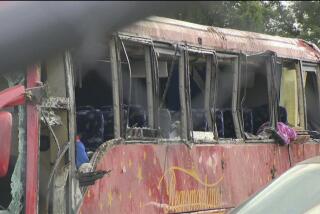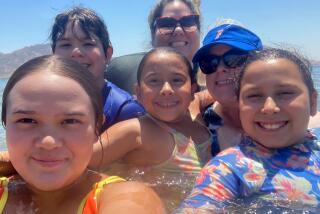Causes of Fatal Girl Scout Bus Crash Detailed : Transportation: A CHP officer says improperly adjusted brakes and poor gear selection led to the accident that left seven people dead.
- Share via
Improperly adjusted brakes and the driver’s failure to use a low enough gear apparently were major factors in the July crash of a chartered school bus near Palm Springs that killed four teen-age Girl Scouts and three adults, a California Highway Patrol officer said Thursday.
Jimmy Cleveland, head of the CHP team that investigated the accident, said the front brakes were “totally out of adjustment” and incapable of slowing the bus as it started down the 9% grade below the Palm Springs Aerial Tramway.
Studies of the wreckage and statements from survivors indicate that the driver--23-year-old Richard Gonzales, who died in the crash--shifted the four-speed automatic transmission into third gear as the bus began to gather speed, the CHP officer said during an interview.
Cleveland, along with others who testified during the first day of National Transportation Safety Board hearings on the crash, said third gear was too high to provide the sort of engine-compression braking that big vehicles need to use--in combination with properly adjusted brakes--to slow down on a steep grade.
With the front brakes inoperable, the rear brakes had to handle the entire load, and examination of the their drums indicates that they failed from overheating, according to reports made public at the Los Angeles hearing.
With nothing left to slow it, the bus carrying 45 Scouts and eight adult advisers continued to gather speed down the steep road.
Cleveland said tire marks indicate the bus was going about 64 m.p.h.--more than twice the posted safe speed--as it began to skid around a sweeping left turn about halfway down the 3.7-mile private road between the tramway parking lot and California 111.
Witnesses say that when a passenger shouted a warning to slow down, Gonzales shouted, “I can’t! Nothing is working!” according to NTSB investigators.
Unable to negotiate the curve, the bus shot off the road, tumbled down a hillside and crashed to a halt in a shallow, boulder-strewn gully. The impact tore the body from the frame of the bus, scattering the dead and injured amid and beyond the battered wreckage.
Stephen J. Bayt, a supervisor with the Allison Transmission Co., which built the transmission, testified Thursday that even if Gonzales had tried to shift to a lower gear, a mechanism designed to keep the engine from over-revving would have automatically shifted it back up into a higher gear.
The safety board, citing its 1987 study of 43 bus accidents, also said Thursday that seat belts would not have reduced the carnage.
Charles Gauthier, a representative of the National Highway Safety Administration, testified Thursday that instead of seat belts, school bus designers rely on a “compartmentalization” concept, using padded, high-backed, closely placed seats to confine the movement of passengers in the event of a crash.
Gauthier said the use of lap-type belts can even increase the incidence of head injuries in some accidents. He said that while window seats could be equipped with shoulder belts, it would be “extremely difficult” to install them on aisle seats.
Cleveland, the CHP officer, also said Thursday that the required pretrip inspection of the bus was made by Gonzales’ sister, Jeanette Cano.
More to Read
Sign up for Essential California
The most important California stories and recommendations in your inbox every morning.
You may occasionally receive promotional content from the Los Angeles Times.









